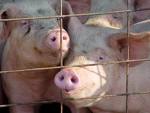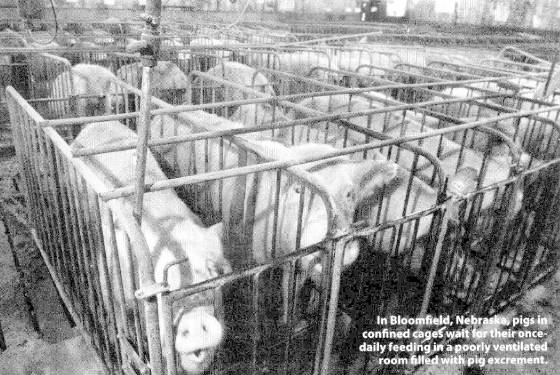Is it the “Mexican Flu”, the “Swine Flu” or the “Human Flu”?
What are the origins of the pandemic?


The WHO announced on May 1st that it will be dropping the designation of “swine flu”. The flu will henceforth be designated A H1N1, to be known more broadly as “the Mexican Flu”, intimating that the disease originated in Mexico through human to human transmission.
Swine influenza refers to “strains of influenza virus, that usually infect pigs”. The terminology, therefore, is important, because if the pandemic is labelled “Mexican flu”, the presumption is that Mexicans, namely humans, are the source of the disease.
The term “Swine Flu’, on the contrary, suggests that the pigs, at least initially, transmit the virus to humans, and, therefore, the issue of animal health must also be addressed.
The news reports have largely focussed on the transmission from humans to humans. They have failed to address the abysmal environmental and health conditions affecting the hog population in factory farms, which are central to an understanding of two fundamental processes:
a) the proliferation of the disease within the hog factory farms.
b) the process of transmission of the virus from pigs to humans.
The swine flu can be transmitted from pigs to humans under very specific circumstances, invariably to people working in hog farms who are exposed on a daily basis to the pigs. Scientists are unequivocal: “People who work with pigs, especially people with intense exposures, are at risk of catching swine flu.”
Swine influenza is an acute, highly contagious, respiratory disease that results from infection with type A influenza virus. Field isolates of variable virulence exist, and clinical manifestation may be determined by secondary organisms. Pigs are the principal hosts of classic swine influenza virus. (Human infections have been reported, but porcine strains of influenza A do not appear to easily spread in the human population. … The disease in swine occurs commonly in the Midwestern USA (and occasionally in other states), Mexico, Canada, South America, Europe (including the UK, Sweden, and Italy), Kenya, China, Japan, Taiwan, and other parts of eastern Asia.(The Merck Veterinarian Manual)

Canadian Pigs Infected by Mexicans
The media has the distinct ability of turning realities upside down. Canada’s print media, radio and network TV, in chorus, point to a Mexican worker on a hog farm in Alberta, identified as being responsible for having infected 220 pigs out of a herd of 2200 in an unnamed central Alberta hog factory farm.
“The bans came quickly after authorities revealed Saturday that a central Alberta pig farm is quarantined under suspicion that a farm worker returning from Mexico spread the “swine flu” to hogs.” (Calgary Herald, May 4, 2009, emphasis added)
Some ten percent of the herd is said to be “recovering”, according to federal officials. A quarantine has been placed on the farm.
“Public-health officials said yesterday they were watching closely for movement of the swine-flu virus between people and pigs after a Canadian herd became infected, but took pains to counter a growing fear around the world of pork products.
As a quarantine was imposed on an unnamed Alberta hog farm where 220 of the herd contracted the novel flu” (National Post, May 4, 2009, emphasis added)
“Pig flu” is not a “novel” phenomenon as suggested by the media, neither is the H1N1 strain. Known and documented pigs are the original source of transmission: from pigs to humans and from humans to humans.
The official story, however, is that the Canadian pigs in the province of Alberta had been infected with swine flu by a Mexican farm worker, namely human to pig transmission. Conversely, these same officials deny the transmission from pigs to humans. The official reports are unequivocal: Canadian pigs could not have infected people working in the hog factory including the Mexican farm worker:
“It was the first time the Canadian Food Inspection Agency had reported a case of the virus being transmitted from a human to a pig in Canada, although this has been known to happen elsewhere.
The agency said the infected herd was quarantined pending more testing “but that the chances the pigs could transfer the virus to humans was remote.” (Reuters, May 2, 2009)
Dr. Brian Evans, a veterinarian with the Canadian Food Inspection Agency (CFIA), stated that “it’s common to see influenza in pigs and human transmission to pigs is known to occur.”

Dead Pigs from Hog Factory Farms
In Mexico, which was identified by the WHO as the original source of the virus, a high incidence of swine flu was recorded in La Gloria, Perote Municipality, Veracruz State.
“Sources characterized the event as a ‘strange’ outbreak of acute respiratory infection, which led to bronchial pneumonia in some pediatric cases. According to a local resident, symptoms included fever, severe cough, and large amounts of phlegm. Health officials recorded 400 cases that sought medical treatment in the last week in La Gloria, which has a population of 3,000; officials indicated that 60% of the town’s population (approximately 1,800 cases) has been affected. No precise timeframe was provided, but sources reported that a local official had been seeking health assistance for the town since February.” (quoted in F. William Engdahl, Flying Pigs, Tamiflu and Factory Farms, Global Research, April 2009)
There are indications that the hog factory farms in Mexico contributed to the initial outbreak of swine flu. La Gloria is a company town, which houses pig farms and surrounding toxic hog manures. Granjas Carroll de Mexico (GCM) is among the world’s largest hog factories, producing almost one million factory hogs per annum. (Ibid) “GCM is a joint venture operation owned 50% by the world’s largest pig producing industrial company, Smithfield Foods of Virginia. (Ibid). Smithfield Foods (SFD) is the world’s largest hog producer and slaughterhouse. With over 14 million hogs per annum, the Mexican plant of La Gloria represents over 7 % of its Worldwide production.
Who is Infecting Whom?
The Alberta incident where a Mexican farm worker allegedly infected 220 pigs, out of a herd of 2200 (exactly ten percent, which suggests an approximation rather than a precise estimate), is crucial to the understanding of the transmission process.
The historical evidence suggests that transmission has, despite precautions, occurred from pigs to humans in giant hog factories.
There is reason to believe that hog factories in North America could potentially be the source of transmission. In the US since 2005, 12 reported cases of swine flu among humans were recorded, all of which were related to direct contact or proximity to pigs, according the the Centre for Disease Control (CDC). These figures do not included unreported cases.
What is the underlying causality. The fundamental question with regard to Alberta and other hog producing regions in North America is: Who is infecting whom?
Did a farm worker returning from Mexico infect the pigs?
Or did the Canadian pigs, confined to an unsanitary, polluted and confined environment, transmit the disease, initially within the 2200 herd, which then led to the infection of humans, namely people working in the hog factory in proximity of the pigs?
If this is the case, the origins and causes of the pandemic are dramatically different to those presented by the WHO and the Obama Administration. We would no longer be dealing with the “Mexican Flu”, transmitted from Mexico, but with a disease which originates in North America’s hog factory farms.
One would at least expect in an investigation that all the facts and causalities underlying the transmission of the virus be carefully examined. The name of the farm in central Alberta has not been released. No press interview or reports have been conducted at the farm on location. The identity of the Mexican worker who allegedly infected the pigs has not been made public. An aura of secrecy prevails: From the available information, the official story that the pigs were infected by a farm worker, who contracted the swine flu in Mexico cannot be corroborated.
In recent developments, six more infections were reported in Alberta (Total 24, May 4, 2009). A young Alberta girl has been hospitalized “with a serious case of human swine flu”
“Alberta Health announced Monday an Edmonton girl is in stable condition in hospital after contracting the disease, although it is not clear where she picked it up since she wasn’t travelling.”
AMERICA’S “WAR ON TERRORISM”
by Michel Chossudovsky
CLICK TO ORDER
In this new and expanded edition of Michel Chossudovsky’s 2002 best seller, the author blows away the smokescreen put up by the mainstream media, that 9/11 was an attack on America by “Islamic terrorists”. Through meticulous research, the author uncovers a military-intelligence ploy behind the September 11 attacks, and the cover-up and complicity of key members of the Bush Administration.
The expanded edition, which includes twelve new chapters focuses on the use of 9/11 as a pretext for the invasion and illegal occupation of Iraq, the militarisation of justice and law enforcement and the repeal of democracy.
According to Chossudovsky, the “war on terrorism” is a complete fabrication based on the illusion that one man, Osama bin Laden, outwitted the $40 billion-a-year American intelligence apparatus. The “war on terrorism” is a war of conquest. Globalisation is the final march to the “New World Order”, dominated by Wall Street and the U.S. military-industrial complex.
September 11, 2001 provides a justification for waging a war without borders. Washington’s agenda consists in extending the frontiers of the American Empire to facilitate complete U.S. corporate control, while installing within America the institutions of the Homeland Security State.
Chossudovsky peels back layers of rhetoric to reveal a complex web of deceit aimed at luring the American people and the rest of the world into accepting a military solution which threatens the future of humanity.
The last chapter includes an analysis of the London 7/7 Bomb Attacks.
CLICK TO ORDER (mail order or online order)
America’s “War on Terrorism”



